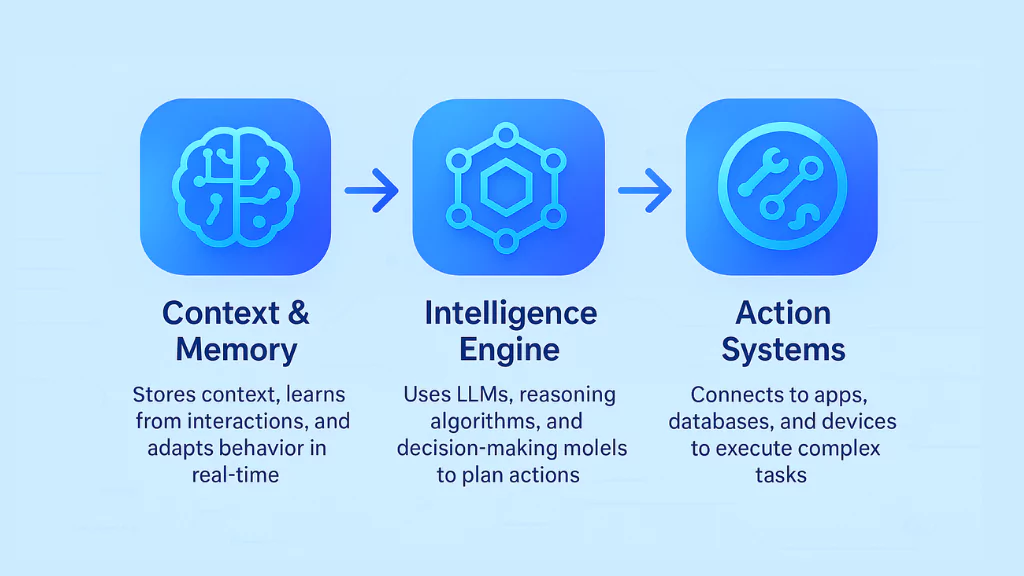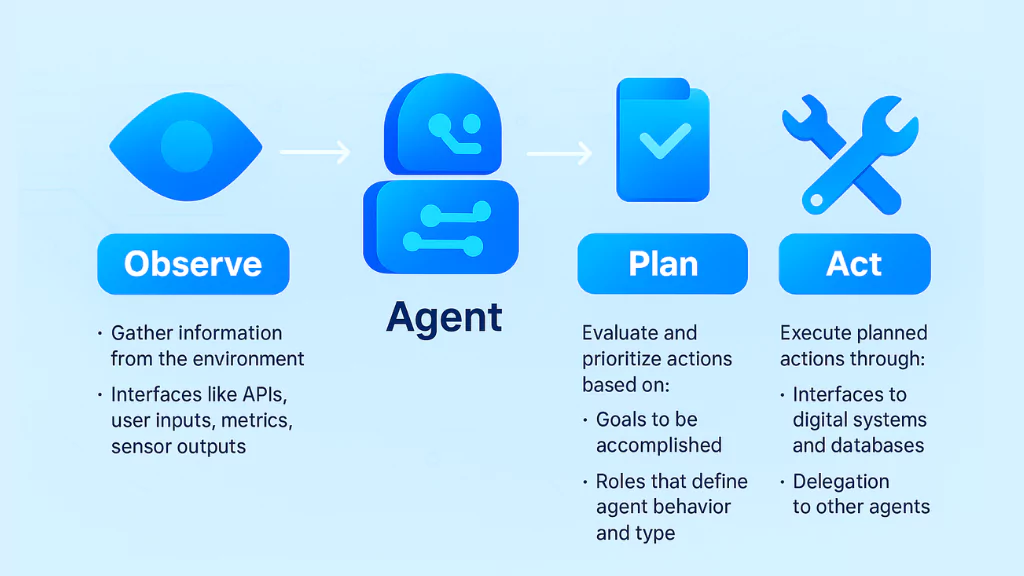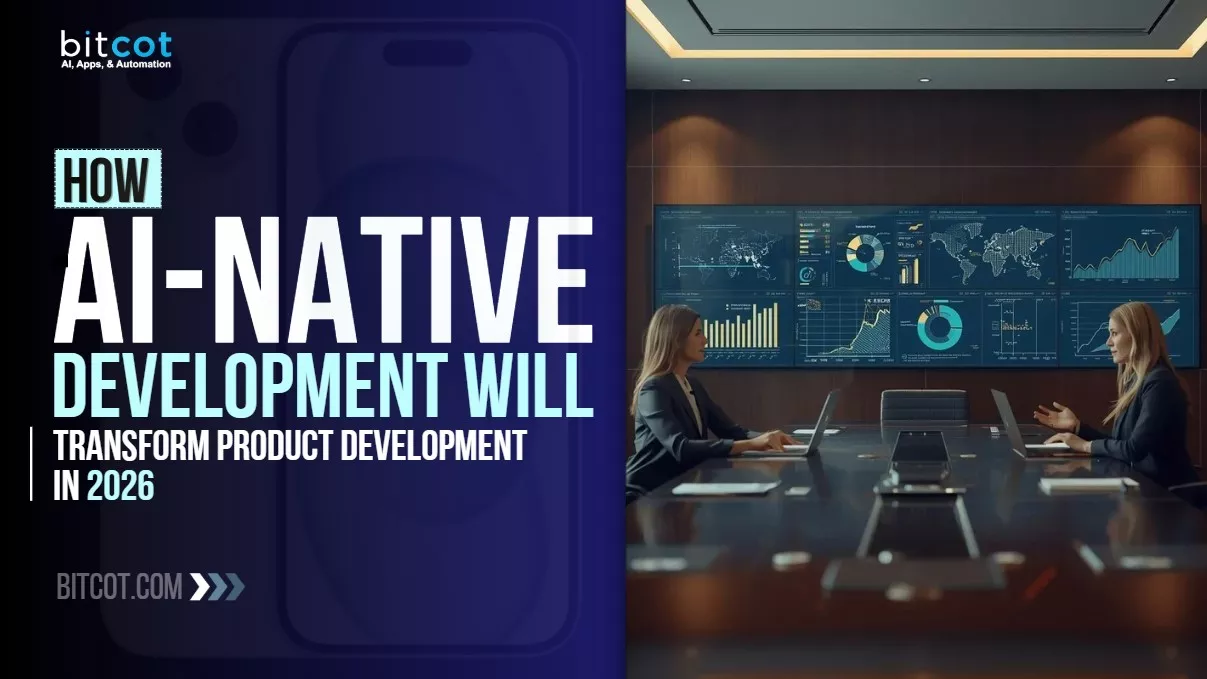
Imagine a world where technology doesn’t just respond to commands but can think, adapt, and make decisions on its own.
It sounds like something straight out of a sci-fi movie, right?
But the truth is, we’re already living in an age where AI agents, smart self-operating systems, are starting to shape everything from customer service to healthcare.
In 2025, AI agents aren’t just a buzzword; they’re transforming industries, making tasks more efficient, and even tackling problems we once thought were unsolvable.
But how do these AI agents actually work? What makes them different from the traditional AI tools we’ve been using for years? And how can you harness their potential?
Let’s dive in and break it all down in this guide.
What Are AI Agents?

At its core, an AI agent is a system that can autonomously perform tasks, make decisions, and interact with its environment in real-time, all without needing constant human input. These agents don’t just follow predefined rules or execute simple commands; they “think,” learn, and adapt based on their experiences.
In simple terms, imagine your smartphone assistant or a chatbot. While they can handle specific tasks, AI agents take this a step further by processing a broader range of information, analyzing situations from multiple angles, and continuously improving their responses over time.
Whether it’s a virtual personal assistant, a robotic process automation (RPA) system, or a complex machine-learning-driven solution, AI agents are designed to “act” rather than just “react.”
The technology behind AI agents has evolved significantly over the years, moving beyond scripted responses or rigid patterns. In 2025, the latest AI agents can assess context, predict outcomes, and make decisions that were once only possible with human input.
To help understand them better, let’s break down the key aspects that define an AI agent:
1. Autonomy
An AI agent’s hallmark is its autonomy; its ability to make decisions and take actions without direct human control. The agent operates independently, often working toward predefined goals or objectives.
For example, an autonomous vehicle doesn’t just follow a set of hardcoded steps. It uses sensors and real-time data to make decisions on its own, adjusting its route to avoid traffic or detect obstacles.
In a smart home, an AI agent can adjust lighting, heating, and even order groceries based on patterns it has learned from your daily habits. It doesn’t need explicit commands every time.
2. Adaptivity
AI agents are designed to adapt to changes in their environment. Unlike traditional systems that require a programmer to tweak their functionality when conditions change, an AI agent can learn from new data and improve its responses or actions.
- Machine Learning: One key way agents adapt is through machine learning. As the agent interacts with the world, it learns from feedback and data patterns, allowing it to optimize its behavior. For instance, a recommendation system in a music app learns your preferences over time, suggesting new songs based on what you’ve liked in the past.
- Reinforcement Learning: Many AI agents use a technique called reinforcement learning. In this case, the agent is like a student learning from experience: it receives feedback in the form of rewards (positive outcomes) or penalties (negative outcomes) for its actions and uses that to fine-tune its behavior.
3. Goal-Oriented Behavior
AI agents are typically built with a goal or set of objectives in mind. These objectives can range from simple tasks, like answering a user’s query, to more complex goals, such as navigating a robot through an obstacle course or making stock market predictions.
- Explicit Goals: For some AI agents, the goals are explicitly defined. For example, an AI agent managing a supply chain has a clear goal: optimize inventory, reduce costs, and ensure timely deliveries.
- Implicit Goals: In other cases, the goals might be more implicit. For example, a personal assistant AI might aim to make the user’s life more efficient by helping them organize their tasks, appointments, and reminders, even if the goals aren’t directly stated.
4. Interactivity
An important characteristic of AI agents is their ability to interact with both humans and other systems. AI agents don’t just process information in isolation; they communicate, respond, and sometimes collaborate with humans or other AI agents.
- Human Interaction: Whether it’s a virtual assistant like Siri or an AI-powered customer service bot, AI agents are often designed to interact with humans in ways that are as natural as possible. This is where natural language processing (NLP) comes into play, allowing the agent to understand and generate human-like responses in text or speech.
- Inter-Agent Collaboration: In more complex scenarios, AI agents can also collaborate with other AI agents. For example, in a factory, multiple robots might work together, each handling a different part of the production process, but all coordinating to complete the task efficiently.
5. Learning and Improvement
AI agents get smarter over time. Through processes like supervised learning, unsupervised learning, and reinforcement learning, they can continually improve their performance based on past experiences and incoming data. This makes AI agents capable of handling ever-evolving tasks.
- Supervised Learning: In this approach, an agent learns by being provided with labeled data. For instance, a spam-filtering AI agent might be trained on a dataset of emails labeled as “spam” or “not spam” and gradually learns to identify new spam emails by recognizing patterns.
- Unsupervised Learning: Here, the agent learns by identifying patterns and structures in data without any labeled outcomes. For example, an AI agent used for market segmentation might analyze purchasing behaviors without being explicitly told what constitutes a “group” of consumers.
- Reinforcement Learning: With reinforcement learning, the agent doesn’t need explicit data. It learns by interacting with the environment and receiving feedback. A robot, for instance, might learn how to walk or navigate through trial and error, gradually improving its movements to achieve its goal.
6. Decision-Making Autonomy
AI agents can make decisions based on the data they perceive and the goals they’re working toward. Unlike simple systems, which only follow a fixed series of steps, AI agents can analyze multiple possible outcomes and choose the most optimal course of action.
- Rule-Based Systems: Some AI agents operate using rule-based systems, where the agent follows a set of predefined “if-then” rules. For instance, a basic AI agent managing traffic lights might switch lights based on a fixed pattern or a simple sensor input.
- Predictive and Optimization Models: Other AI agents use more advanced models that predict future events and optimize their actions accordingly. For instance, in a smart grid system, AI agents predict electricity demand patterns and adjust power distribution dynamically to prevent overloads and minimize energy waste.
Types of AI Agents (and How Businesses Use Them)
AI agents aren’t all built the same. The “type” of agent determines how it processes information, makes decisions, and interacts with its environment. In 2025, understanding these differences isn’t just a tech curiosity; it’s critical for making the right investment decisions.
Below are the main categories of AI agents, along with the ways businesses are putting them to work.
1. Reactive Agents
Reactive agents are the simplest type. They don’t store memories or learn from past actions; they respond directly to the current state of the environment. Their strength is speed and reliability in situations where rules are fixed and decisions are immediate.
Key capabilities:
- Respond instantly to environmental changes
- Low complexity, minimal processing requirements
- Highly predictable behavior
Business use cases:
- Manufacturing safety: Automatically shutting down machinery if sensors detect overheating or unusual vibrations.
- Network security: Blocking suspicious IP addresses in real time when a threat is detected.
- Retail operations: Activating price changes instantly when inventory falls below a certain threshold.
Example: In a warehouse, a reactive AI agent linked to robotic arms can stop movement instantly if a human enters a restricted safety zone, avoiding accidents.
2. Model-Based (Deliberative) Agents
Model-based agents create and maintain an internal model of the environment. This lets them simulate possible outcomes before acting, making them more flexible and capable of handling uncertainty.
Key capabilities:
- Build a representation of the world
- Predict future states based on different actions
- Adjust strategies when the model changes
Business use cases:
- Logistics: Forecasting delivery delays by combining traffic, weather, and order volume data, then adjusting routes in real time.
- Energy management: Predicting peak electricity demand hours and adjusting energy storage or generation accordingly.
- Retail planning: Anticipating seasonal demand changes and adjusting inventory orders before shortages occur.
Example: A global shipping company uses a model-based agent to simulate different shipping routes when storms are forecasted, choosing the option that minimizes delays and costs.
3. Goal-Based Agents
Goal-based agents operate with a clear objective in mind. They evaluate potential actions and select those that bring them closer to achieving that goal, even in changing conditions.
Key capabilities:
- Prioritize actions based on a desired end result
- Recalculate strategies when obstacles arise
- Flexible in dynamic environments
Business use cases:
- Marketing optimization: Continuously reallocating advertising budgets to meet a target ROI.
- Sales enablement: Identifying which leads to prioritize based on likelihood to convert within a quarterly target.
- Project management: Scheduling tasks and resources to meet strict deadlines.
Example: A SaaS company’s goal-based agent monitors lead activity and automatically prioritizes follow-ups for the sales team to ensure quarterly revenue targets are met.
4. Utility-Based Agents
Utility-based agents make decisions by weighing multiple possible outcomes against a utility function, a score that represents how desirable each outcome is. This allows them to handle trade-offs where not every decision is black-and-white.
Key capabilities:
- Quantify “how good” each possible action is
- Balance competing priorities
- Choose the most beneficial outcome under constraints
Business use cases:
- Energy pricing: Balancing cost, environmental impact, and supply availability when deciding when to buy or store energy.
- Resource allocation: Assigning limited staff across multiple projects to maximize overall business value.
- Supply chain management: Choosing between faster but costlier shipping vs. slower but cheaper options, based on current demand.
Example: An airline uses a utility-based agent to decide whether to delay a flight slightly to allow connecting passengers to board, weighing customer satisfaction against operational costs.
5. Learning Agents
Learning agents improve their performance over time by gathering feedback and updating their decision-making processes. They often use machine learning and reinforcement learning to adapt without being explicitly reprogrammed.
Key capabilities:
- Self-improvement through experience
- Can handle new, previously unseen situations
- Often the most versatile type for long-term deployment
Business use cases:
- Customer service: Continuously improving chatbot responses based on past conversations.
- Fraud detection: Adapting to new fraud tactics by learning from recent patterns.
- Operations optimization: Refining scheduling algorithms based on historical productivity data.
Example: An eCommerce company’s learning agent starts with a basic product recommendation system, then continuously refines suggestions as it sees which items customers actually purchase.
How Do AI Agents Work?

AI agents work by integrating various technologies to process information, make decisions, and take action. To break it down, we can look at the four fundamental stages that an AI agent goes through to complete a task: Perception, Reasoning, Decision-Making, and Action.
Let’s explore each one in detail:
1. Perception: Gathering Data from the Environment
The first step for an AI agent is to perceive its environment, whether it’s a physical space or a digital one. Perception is the process by which an AI agent collects data about the world. Depending on the type of agent, this can involve sensory inputs, digital signals, or raw data.
- Sensors and Inputs: For physical AI agents (like autonomous vehicles or robots), perception often comes from sensors such as cameras, LiDAR (Light Detection and Ranging), radar, infrared, and microphones.
- Text and Speech Input: For digital AI agents (like chatbots or voice assistants), the perception might come from text inputs (like written questions or commands) or voice recognition. These AI agents use natural language processing (NLP) techniques to interpret spoken or written words.
- Environmental Context: Beyond raw sensory data, some agents can also gather contextual information like location, time of day, weather, or user preferences. For example, a smart thermostat gathers environmental data like room temperature and learns your habits to adjust heating or cooling accordingly.
Key Takeaway: The perception stage is all about gathering raw information from the environment, whether through physical sensors, digital inputs, or both.
2. Reasoning: Understanding and Interpreting the Data
Once the AI agent perceives the world, it needs to interpret and make sense of the information. This stage is known as reasoning. Here, the agent uses algorithms to process the raw data and extract meaningful insights.
- Machine Learning Models: AI agents typically use machine learning models, such as decision trees, neural networks, or support vector machines, to analyze the data they collect. These models have been trained on large datasets to recognize patterns, trends, and relationships within the data.
- Natural Language Processing (NLP): For digital AI agents interacting with humans in natural language, reasoning often involves NLP. This allows the agent to parse and understand the intent behind human language. NLP enables chatbots to differentiate between a request for help and a casual greeting, and even to handle ambiguous statements.
- Contextual Reasoning: More advanced AI agents can also reason about the context of a situation. For instance, a virtual assistant might understand that if you ask, “What’s the weather like tomorrow?” it’s because you’re likely planning to leave the house, and it might also pull up your calendar to suggest whether you need an umbrella for an outdoor meeting.
Key Takeaway: In this phase, the AI agent interprets the data through algorithms, learns from patterns, and grasps the underlying meaning behind the raw information. It turns sensory data into actionable knowledge.
3. Decision-Making: Choosing the Best Action
Now that the AI agent has understood the context and interpreted the data, it’s time to decide what action to take. This is where decision-making comes into play, and it is influenced by both predefined rules and learned behaviors.
- Rule-Based Systems: Some simpler AI agents rely on fixed rules or decision trees. These rules dictate what the agent should do based on specific inputs. For example, an AI agent in a banking app might have a rule that says, “If the user requests a transaction history, retrieve the last 5 transactions from the database.”
- Reinforcement Learning (RL): More advanced AI agents use reinforcement learning, a machine learning technique that allows them to learn from experience. In RL, the agent explores different actions and receives feedback in the form of rewards or penalties. Over time, it adjusts its behavior to maximize the reward.
- Optimization Algorithms: Many AI agents use optimization techniques to make decisions. For example, an AI managing a supply chain might use optimization algorithms to determine the best route for delivery trucks, minimizing fuel costs or delivery time while maximizing efficiency.
- Predictive Models: Some agents use predictive models to make decisions based on data trends and forecasts. For instance, a financial advisor AI might predict stock prices based on historical market data and choose whether to buy or sell based on expected future performance.
Key Takeaway: The decision-making stage involves selecting the best possible action based on reasoning, learned patterns, and either predefined rules or dynamic optimization methods.
4. Action: Implementing the Decision
The final stage of an AI agent’s workflow is action; this is where it actually carries out the decision it has made. Actions can be physical (in robots or autonomous vehicles) or digital (in chatbots or virtual assistants). This phase often involves interacting with the environment or executing specific tasks.
- Acting in the Physical World: For robotic AI agents, the action involves executing commands through motors, robotic arms, or other physical mechanisms. For instance, a robot performing warehouse inventory might pick up boxes and transport them based on instructions it received earlier.
- Digital Actions: For virtual assistants, chatbots, or AI in software, actions might involve sending emails, updating data, generating reports, or even making online purchases. For example, an AI in an e-commerce app might recommend products based on the user’s browsing history or make a purchase on behalf of the user after analyzing the best deals.
- Autonomous Systems Coordination: In more complex environments, multiple AI agents may need to coordinate their actions. For example, a swarm of drones may work together to deliver packages. Each drone might decide on its route based on real-time data and then communicate with others to avoid collisions and optimize the delivery process.
Key Takeaway: In the action phase, the AI agent takes the necessary steps to execute its decision, whether it’s manipulating the physical environment or performing digital tasks.
Why are AI Agents Important for Businesses in 2025?
If you’re running a business in 2025, you’ve probably noticed a shift: it’s no longer just about working faster; it’s about working smarter at scale. That’s exactly where AI agents come in.
These aren’t just another automation tool. Unlike traditional systems that follow the same set of rules no matter what’s happening, AI agents can adapt on the fly. They read the situation, weigh the options, and act, often before a human even realizes there’s a decision to make.
Take supply chains. An AI agent can spot a supplier delay, reroute shipments, and update delivery estimates instantly without waiting for a meeting or a manager’s approval. In finance, agents can watch the markets 24/7, flag emerging risks, and suggest hedging strategies before volatility hits.
In customer service, they can resolve issues in seconds, at scale, while keeping the human team free for complex cases.
The real magic? Scalability. Imagine the decision-making power of your best employee, replicated across hundreds, or thousands, of simultaneous situations. That’s what AI agents make possible. They turn bottlenecks into smooth workflows and let your team focus on strategy instead of firefighting.
And here’s the strategic kicker: companies that are putting AI agents to work now are pulling ahead fast. They’re cutting costs, yes, but they’re also launching products faster, spotting opportunities earlier, and keeping customers happier. Competitors who wait will find themselves not just behind on efficiency, but behind on innovation itself.
In short, AI agents in 2025 aren’t a “nice-to-have” experiment. They’re a competitive edge, one that’s quickly becoming the baseline for staying relevant in almost every industry.
Benefits of AI Agents for Businesses
In 2025, AI agents are more than just an efficiency upgrade; they’re a strategic asset. When deployed effectively, they can reshape entire workflows, improve decision-making, and open new revenue streams.
Let’s break down the key benefits businesses are seeing right now.
Increased Operational Efficiency
AI agents don’t just speed up processes; they streamline them. By automating repetitive tasks and handling routine decision-making, they free up human teams for higher-value work.
- Example: A logistics company uses AI agents to optimize delivery routes in real time, cutting fuel costs by 12% while improving on-time performance.
- Impact: Reduced labor costs, faster turnaround times, and less wasted effort.
Data-Driven Decision-Making at Scale
Unlike human teams, AI agents can process massive datasets instantly and consistently. They can spot patterns, anomalies, and opportunities that would otherwise go unnoticed.
- Example: A retail chain deploys AI agents to analyze sales data from hundreds of stores daily, adjusting pricing and promotions dynamically to maximize margins.
- Impact: Faster, more informed decisions that align with market realities.
Improved Customer Experience
AI agents can provide 24/7, personalized service, something that’s hard to scale with human staff alone.
- Example: A bank’s AI agent answers customer queries instantly, tailors product recommendations based on account activity, and escalates complex cases to a human representative.
- Impact: Shorter wait times, higher satisfaction scores, and better retention rates.
Agility in Changing Conditions
Markets shift. Supply chains get disrupted. Customer preferences evolve. AI agents can respond in real time.
- Example: During a supply shortage, an AI agent in procurement automatically identifies alternative suppliers, renegotiates terms, and adjusts orders without halting operations.
- Impact: Business continuity and resilience in the face of uncertainty.
Consistency and Compliance
Unlike humans, AI agents don’t get tired, distracted, or inconsistent. They can apply rules and regulations the same way every time, reducing compliance risks.
- Example: In financial services, an AI agent reviews transactions for potential compliance issues before they’re processed, flagging anomalies instantly.
- Impact: Lower regulatory risk and fewer costly errors.
Cost Reduction and ROI Growth
Yes, AI agents require upfront investment, but the long-term savings and revenue opportunities are substantial.
- Example: A manufacturing plant implements AI agents for predictive maintenance, preventing costly downtime and extending equipment lifespan.
- Impact: Lower operating expenses, faster payback periods, and improved profit margins.
Use Cases of AI Agents for Businesses in 2025
By 2025, AI agents have moved far beyond basic chatbots and process automation. They’re now embedded in almost every business function, quietly driving efficiency, revenue, and innovation.
Here are some of the most impactful ways companies are putting them to work.
1. Customer Service and Support
AI agents can handle high volumes of customer inquiries instantly, delivering fast and consistent responses while escalating complex cases to human agents.
- Example: A telecom company uses AI agents to resolve billing queries, troubleshoot technical issues, and upsell relevant plans, all within a single interaction.
- Business impact: Reduced call center costs, higher satisfaction scores, and better upsell conversion rates.
2. Sales and Lead Management
AI agents can qualify leads, score prospects, and even engage them in personalized conversations before a salesperson steps in.
- Example: A B2B SaaS provider deploys AI agents to track prospect behavior on its website, trigger targeted outreach emails, and schedule meetings automatically.
- Business impact: Shorter sales cycles and improved lead-to-close ratios.
3. Marketing Optimization
Marketing AI agents analyze campaign data in real time, adjusting bids, budgets, and creatives based on performance trends.
- Example: An e-commerce brand uses AI agents to shift ad spend between channels based on ROI, while automatically generating product-specific ad copy.
- Business impact: Higher return on ad spend and reduced wasted budget.
4. Supply Chain and Logistics
From route optimization to inventory forecasting, AI agents keep goods moving efficiently, even in unpredictable conditions.
- Example: A global distributor uses AI agents to reroute shipments during port delays, while automatically updating customers with revised ETAs.
- Business impact: Fewer disruptions, lower transportation costs, and improved customer trust.
5. Human Resources and Recruitment
AI agents can screen applications, schedule interviews, and assess candidates based on skill and cultural fit.
- Example: A large enterprise uses an AI agent to review resumes, score applicants, and send interview invites, reducing time-to-hire from weeks to days.
- Business impact: Faster hiring, better talent matching, and reduced recruiter workload.
6. Financial Analysis and Risk Management
AI agents process real-time market data, monitor transactions, and flag unusual activity.
- Example: An investment firm uses AI agents to scan for portfolio risks and recommend asset rebalancing strategies instantly.
- Business impact: More proactive decision-making and reduced exposure to financial risks.
7. Predictive Maintenance and Operations
In manufacturing and heavy industries, AI agents can anticipate equipment failures before they happen.
- Example: An automotive plant’s AI agents detect subtle performance drops in machinery, scheduling maintenance during low-demand periods to avoid costly downtime.
- Business impact: Extended asset life, fewer breakdowns, and improved production efficiency.
Cost of Building AI Agents for Business Applications
By 2025, the cost of building AI agents has become more accessible than in the early days, but it’s still a serious investment, especially if you want agents tailored to your specific business needs. Understanding what drives these costs will help you plan realistically and avoid budget surprises.
1. Scope and Complexity of the Agent
The more advanced the agent’s capabilities, the higher the development cost.
- Basic reactive agent: Handles straightforward, rule-based decisions. Often costs $10,000-$30,000 to develop for a single use case.
- Advanced goal-based or learning agent: Requires predictive modeling, machine learning, or integration with multiple data sources. Development can range from $50,000 to $250,000+, depending on complexity.
Example: A customer support chatbot with preset answers will be far cheaper than a multilingual, learning-enabled agent that integrates with CRM, ERP, and payment systems.
2. Data Requirements
AI agents need high-quality data to perform well. Costs here can include:
- Data collection (internal systems, IoT devices, third-party APIs)
- Data cleaning and preprocessing
- Annotation and labeling for training datasets
For many businesses, preparing and securing data can account for 20-40% of the total project budget.
3. Development Team and Expertise
You’ll need specialists such as AI engineers, data scientists, UX designers, and integration experts.
- In-house build: Higher upfront salaries but more control over the process.
- Outsourced to AI development firms: Typically $100-$300 per hour, depending on expertise and location.
Some companies reduce costs by using prebuilt AI frameworks from providers like OpenAI, Google Cloud, or Microsoft Azure, but customization still requires skilled developers.
4. Infrastructure and Hosting
AI agents, especially those using real-time analytics or machine learning, require powerful computing resources. Costs can include:
- Cloud computing (AWS, Azure, GCP) billed by usage
- Edge computing hardware for on-site deployments
- Storage for large datasets
For cloud-based AI agents, expect $500-$5,000 per month for infrastructure, scaling higher for large deployments.
5. Integration with Business Systems
The more systems your agent needs to connect with (CRM, ERP, supply chain software, IoT devices), the more development time is required. Integration often accounts for 15-30% of total project costs.
6. Ongoing Maintenance and Updates
AI agents aren’t “set and forget.” They require:
- Model retraining as data changes
- Security patches and compliance updates
- Performance monitoring and fine-tuning
Maintenance typically costs 15-25% of initial development costs annually.
Future Trends: What’s Next for AI Agents in Business?
AI agents have already transformed many parts of business operations by 2025, but the story is just getting started. Looking ahead, several exciting trends are shaping how AI agents will evolve, and how companies can stay ahead of the curve.
Hyper-Personalization at Scale
AI agents will become even better at delivering ultra-tailored experiences, not just for customers, but for employees, partners, and suppliers too. By analyzing deeper behavioral data and context in real time, agents will anticipate needs and preferences with unprecedented accuracy.
Business impact: Imagine sales agents that know exactly when to engage prospects, or HR agents that personalize employee development plans dynamically. This kind of personalization drives loyalty and efficiency like never before.
Increased Collaboration Between AI Agents and Humans
Rather than replacing people, AI agents will work as seamless collaborators, handling routine tasks and offering smart recommendations so humans can focus on strategic decisions. Expect more intuitive interfaces, natural language understanding, and mixed-reality environments where agents assist in real time.
Business impact: Teams will get more done with less burnout, and decision-making will become faster and more confident.
Autonomous Multi-Agent Systems
Instead of single agents working in isolation, future AI systems will feature multiple agents collaborating autonomously across business functions, sharing data, negotiating, and solving complex problems together.
Business impact: Supply chains could self-optimize end-to-end, and customer journeys could be managed holistically across marketing, sales, and support without manual handoffs.
Explainability and Trust
As AI agents take on more critical roles, businesses will demand transparency in how decisions are made. Advances in explainable AI (XAI) will let agents provide clear, understandable reasons for their actions, crucial for compliance and user confidence.
Business impact: Easier regulatory approval, reduced risk, and stronger stakeholder trust.
Edge AI and Real-Time Processing
AI agents will increasingly operate at the “edge” directly on devices like smartphones, sensors, or industrial machines, allowing for faster responses and enhanced privacy by processing data locally.
Business impact: Real-time decision-making in manufacturing, logistics, and customer interactions without relying on constant cloud connectivity.
Democratization of AI Agent Development
With more powerful no-code/low-code platforms emerging, business users (not just developers) will be able to build and customize AI agents tailored to their needs.
Business impact: Faster innovation cycles, reduced IT bottlenecks, and greater agility in responding to market demands.
Final Thoughts
AI agents are transforming business in 2025, and we at Bitcot know how exciting and sometimes challenging it can be to bring this technology into your company.
Whether you’re just starting to explore AI agents or ready to build advanced, intelligent solutions, we’re here to make the process smooth and effective. We partner closely with you to understand your unique goals, design AI agents that fit your needs, and help you unlock real value, like saving time, cutting costs, and improving customer experiences.
We also understand that every business is unique. That’s why we don’t believe in one-size-fits-all solutions. We take the time to learn about your challenges and goals so the AI agents we build fit seamlessly into your workflows and grow with your business. Your success is our success.
At Bitcot, it’s not just about the technology; it’s about delivering solutions that drive growth and keep you ahead of the competition. If you’re ready to see what our AI agent development services can do for your business, let’s connect and build something great together.












